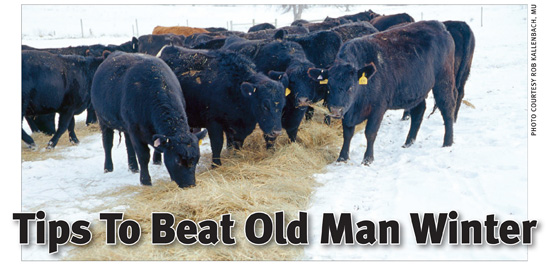All-weather feed structures make winter chores a breeze.
When winter winds howl through the Smokey Mountains, Angus breeder David Freeman of Mars Hill, N.C., appreciates his versatile winter feed structure. These open-sided structures are built on concrete pads and combine hay feeding racks or silage feeders with freeze-proof water fountains and manure storage areas under the roof.
The racks in Freeman's structure are built on wheels and hold up to 10 days' supply of hay. During winter, Freeman scrapes the concrete pads with his tractor/loader and stores the manure until it's time in early spring to apply the nutrients to pastures as fertilizer.
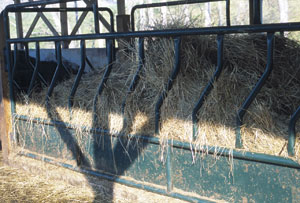
Racks reduce hay waste compared to feeding bales on the ground.
By feeding hay in racks protected from weather damage, hay waste is reduced by up to 40% compared to feeding bales on the ground. The concrete pads provide firm footing and a healthy environment for cattle. Storing the manure during winter and applying the nutrients to pastures at the optimum time saves approximately $1,400 per year in fertilizer value and protects the water quality in nearby streams.
"Based on the high price of fertilizer, the nutrients from the manure are very valuable. Even with the racks, cattle pull out some hay and it mixes with manure to make organic matter that improves soil structure. I apply the material from the feed structure to the poorest areas of my pastures and my brother applies the material to his lawn. He's got the greenest lawn in town," Freeman says.
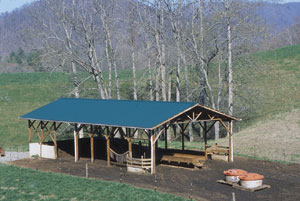
Winter feed structures combine hay racks, water tanks, concrete pads and manure storage areas.
A winter feed structure for 30 cows consists of a 45 ×
27-foot (ft.) concrete pad with a 27 × 16-ft. area for storing manure. Gutters collect the runoff water from the structure's roof and keep heavy rains from washing livestock waste into streams.
Freeman raises Wye Angus cattle and sells seedstock to ranchers across the country. The mountain cattleman is particularly thankful for the health benefits provided by his winter feed structures.
"Storing manure improves the health of my cattle. Feeding the cows on concrete keeps them out of deep mud and prevents contamination of their udders for better health of the nursing calves," Freeman says.
Do-it-yourself project
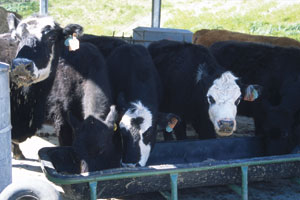
Concrete pads provide healthy feed areas for cattle.
The winter feed structures built in North Carolina were designed by the Natural Resources Conservation Service (NRCS) to protect streams from livestock waste runoff and were built with U.S. Department of Agriculture (USDA) cost-share assistance. The structures designed by NRCS cost approximately $15,000, but the landowner paid only 25% of the cost. Unfortunately, USDA cost-share funds for winter feed structures have dried up, and very few structures have been built recently.
However, innovative cattlemen have designed similar winter feed areas and built the structures with salvaged materials for less than $5,000. John Sparks of Lawrence County, Ky., has built two winter feed structures for his cow-calf operation. The racks in his covered structures hold a three- to five-day supply of hay and protect the feed from weather damage. Freeze-proof water tanks provide water for the cattle all winter. Collecting and storing the manure for application on pastures turns animal waste into valuable fertilizer.
"With the increased prices of nitrogen, potash and phosphorus the cattle manure has become very valuable as fertilizer on my pastures. I also work the organic material into my commercial vegetable fields to improve fertility and soil structure," says the retired University of Kentucky Extension agent.
Flexible feeding areas
Of course, permanent winter feed structures don't work for every situation. Many producers need the flexibility provided by feeding round bales of hay to cattle in pastures. In these situations, there are key steps to make winter feeding more cost-effective.
First of all, hay is an expensive feed, but up to 40% of nutrients in round bales is wasted due to poor storage and feeding techniques. When bales are stored outside, hay is wasted because weather damages the outer layers of the bales and cattle refuse to eat the spoiled forage.
Storing hay in shelters or protected by plastic reduces waste by 20%-30%. According to research at Virginia Tech, storing hay in a shelter saves a producer $24 per ton, or approximately $2,100 per year when 90 tons of hay ($119 per ton) are fed to a 30-cow beef herd.
In addition to the hay wasted during outdoor storage, feeding losses run from 12% (one-day supply) to 43% (seven-day supply) when round bales are fed on the ground without using rings or racks, according to University of Missouri (MU) research. Depending on the style of feeder, losses are held to approximately 5% when hay is fed in rings or racks.
A lot of hay quality is also lost when weather causes harvest delays that allow forages to reach late maturity. MU forage specialist Robert Kallenbach points out that at peak quality fescue/clover hay may have crude protein (CP) of 18% and total digestible nutrients (TDN) in the 60 percentile. Beef cows should maintain good body condition through winter on hay of this quality. If harvest of fescue/clover hay is delayed until seed heads mature, CP may drop to 7% and TDN may fall into the low 5 percentiles. When hay quality falls to this level, cows may need supplements to maintain body condition.
Speed feeding
The MU Forage Systems Research Center has developed a low-labor system for feeding large round bales in hay rings. In this system, the bales are grouped in a pasture before winter-feeding begins. Locating bales in the feeding area before bad weather reduces labor and damage to pastures from running trucks and tractors to move hay across muddy fields.
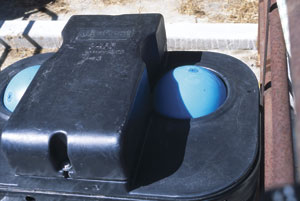
Freeze-proof water tanks overcome a major problem for winter cattle care.
In the MU system, round bales are spaced on 20-ft. centers with the number of bales per pasture based on bale size, animal numbers and the length of feeding period. For example, a 30-cow herd may require one 900-lb. bale a day, so placing 10 bales in a paddock supplies 10 days worth of feed or five days of feed for a 60-cow herd. The bale storage area is blocked off with electric fence. At feeding time, the portable fence is moved and rings are placed around a two- or three-day supply of bales. A big advantage to this system is that a three-day supply of hay for 60 cows can be fed in 20 minutes.
If a three-day supply of round bales were unrolled in the pasture so that cattle trample and bed down in the hay, feeding losses run around 40%. When possible, round bales should be fed at several locations across pastures to spread manure as cattle recycle the nutrients. Depending on the price of fertilizer, cattle will recycle nutrients worth $20-$30 as pasture fertilizer from a 900-lb. round bale of hay.
Comment on this article.





